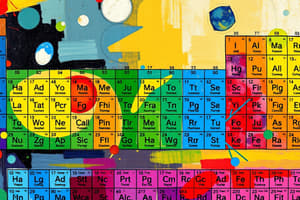Podcast
Questions and Answers
Which of the following is a characteristic of nonmetals?
Which of the following is a characteristic of nonmetals?
- High electronegativity (correct)
- Tend to be shiny solids
- High malleability
- Good conductors of electricity
What is a common property of nonmetals when they are solid?
What is a common property of nonmetals when they are solid?
- Brittle or crumbly (correct)
- Low electronegativity
- Good conductors of heat
- High ductility
What type of oxides do nonmetals tend to form?
What type of oxides do nonmetals tend to form?
- Amphoteric
- Basic
- Neutral
- Acidic (correct)
Which two elements make up about 98% of the observable ordinary matter in the universe by mass?
Which two elements make up about 98% of the observable ordinary matter in the universe by mass?
What is the general trend for the density of nonmetals?
What is the general trend for the density of nonmetals?
Flashcards are hidden until you start studying
Study Notes
Characteristics of Nonmetals
- Nonmetals are generally poor conductors of heat and electricity, contrasting with metals which are good conductors.
- They have higher ionization energies and electronegativities compared to metals.
Common Properties of Solid Nonmetals
- Solid nonmetals are typically brittle, meaning they shatter or break easily instead of deforming.
- Examples include sulfur and phosphorus, which do not exhibit the malleable properties characteristic of metals.
Types of Oxides Formed by Nonmetals
- Nonmetals tend to form acidic oxides when combined with oxygen, such as carbon dioxide (CO2) and sulfur trioxide (SO3).
- These oxides often react with water to create acidic solutions (e.g., carbonic acid from CO2).
Major Components of Ordinary Matter
- Hydrogen and helium compose approximately 98% of the observable ordinary matter in the universe by mass.
- These two elements are fundamental to stellar formation and the evolution of the universe.
Density Trends in Nonmetals
- The general trend shows that nonmetals have lower densities compared to metals, particularly in their solid states.
- Exceptions exist, like bromine, which is a liquid nonmetal with density higher than some solids.
Studying That Suits You
Use AI to generate personalized quizzes and flashcards to suit your learning preferences.




